A Comparative Study on Gemological Characteristics and Color Formation Mechanism of Moqi Agate, Inner Mongolia Province, China
Abstract
:1. Introduction
2. Materials and Methods
2.1. Agate Sample
2.2. Methods
3. Results and Discussion
3.1. Polarization Inspection
3.2. Infrared Spectra
3.3. Raman Spectra
3.4. Moganite Content of Moqi Agate
3.5. XRD
3.6. Calculation of Crystallinity
3.7. Composition Analysis of Agate
3.8. UV–Visible Spectroscopy
4. Conclusions
Supplementary Materials
Author Contributions
Funding
Acknowledgments
Conflicts of Interest
References
- Cai, W.; Tian, J. Classification of Agate. China Nonmetal Min. Ind. Guide 2000, 4, 29–31. [Google Scholar]
- Xie, T. Study on Coloration Mechanism and Structural Genesis of “Warring States Red” Agate in Fuxin, Liaoning. Master’s Thesis, China University of Geosciences (Beijing), Beijing, China, 2014. [Google Scholar]
- Götze, J.; Nasdala, L.; Kleeberg, R. Occurrence and distribution of “moganite” in agate/chalcedony: A combined micro-Raman, Rietveld, and cathodoluminescence study. Contrib. Mineral. Petrol. 1998, 133, 96–105. [Google Scholar] [CrossRef]
- Currier, R.H. Amethyst, agate, and calcite ‘skunks’ from Uruguay. Rocks Miner. 1997, 72, 94. [Google Scholar] [CrossRef]
- Moxon, T. Agates from Western Australia Found in a 3,480-Million-Year-Old Host Rock. Rocks Miner. 2010, 85, 66–73. [Google Scholar] [CrossRef]
- Zhou, D.; Chen, H.; Lu, T.; Ke, J.; He, M. The relationship between the relative content of moganite and the crystallinity of quartz jade was studied based on Raman spectroscopy infrared spectroscopy X-ray diffraction. Rock Miner. Test. 2015, 6, 652–658. [Google Scholar]
- Guo, W.; Wang, S. Mineralogical characteristics and chromogenic mechanism of Nanhong agate in Baoshan, Yunnan. J. Rock Mineral. 2017, 36, 419–430. [Google Scholar]
- Zhu, L.; Yang, M.; Tang, J.; Yang, X. Gemmological Characteristic of Nanhong Agate and Formation of Red Stripe. J. Gemol. Gemol. 2015, 6, 31–38. [Google Scholar]
- Lu, Z.; He, X.; Lin, C.; Jin, X.; Pan, Y. Identification of Beihong Agate and Nanhong Agate from China Based on Chromaticity and Raman Spectra. Spectrosc. Spectr. Anal. 2019, 39, 2153–2159. [Google Scholar]
- Tao, M.; Xu, H. Structure, water content and genetic mechanism of agate. J. Rock Mineral. 2016, 35, 333–343. [Google Scholar]
- Zhang, Z.; Zhao, T.; Liu, L.; Li, Y. Spectral Characteristics of Madagascar Agates. Spectrosc. Spectr. Anal. 2021, 41, 3227–3232. [Google Scholar]
- Farmer, V.C. Infrared Spectra of Minerals; Mineralogical Society: London, UK, 1992; p. 100. [Google Scholar]
- Heaney, P.J.; Post, J.E. The widespread distribution of a novel silica polymorph in microcrystalline quartz varieties. Science 1992, 255, 441–443. [Google Scholar] [CrossRef] [PubMed]
- Luo, Y.; Wang, C. Distinguishing between phanerocrystalline quartzite and cryptocrystalline chalcedony by infrared specular reflection. In Proceedings of the China Jewelry Academic Exchange Conference, Beijing, China, 30 November 2015; Volume 7. [Google Scholar]
- Yang, L.; Yan, S.; Wang, H.; Zhang, Y.; Wang, R.; Yang, M. Spectral Characteristics of Two Kinds of Nanhong Agate Imitations. Spectrosc. Spectr. Anal. 2022, 42, 835–840. [Google Scholar]
- Dana, P.; Ciprian, C.; Tătar, D.; Wolfgang, K. Raman spectroscopy on gem-quality microcrystalline and amorphous silica varieties from Romania. Stud. UBB Geol. 2004, 49, 41–52. [Google Scholar]
- Kingma, K.J.; Hemley, R.J. Raman spectroscopic study of microcrystalline silica. Am. Mineral. 1994, 79, 269–273. [Google Scholar]
- Zhou, D.; Shi, G.; Liu, S.; Wu, B. Mineralogy and Magnetic Behavior of Yellow to Red Xuanhua-Type Agate and Its Indication to the Forming Condition. Minerals 2021, 11, 877. [Google Scholar] [CrossRef]
- Liu, F.; Lin, X. Goethite morphologies of some soils in south of central China. Pedosphere 1996, 3, 193–200. [Google Scholar]
- Hatipoğlu, M. Moganite and quartz inclusions in the nano-structured Anatolian fire opals from Turkey. J. Afr. Earth Sci. 2009, 54, 1–21. [Google Scholar] [CrossRef]
- Kingma, K.J. Pressure-Induced Transformations in Silica. Ph.D. Thesis, The Johns Hopkins University, Baltimore, MD, USA, 1994. [Google Scholar]
- Peter, J. Heaney Moganite as an indicator for vanished evaporites: A testament reborn? J. Sediment. Res. 1995, 65, 633–638. [Google Scholar]
- He, M.; Wang, P. Crystallinity index of quartz and its typomorphic significance. Miner. Rocks 1994, 14, 22–28. [Google Scholar]
- Murata, K.J.; Norman, M.B. An index of crystallinity for quartz. Am. J. Sci. 1976, 276, 1120–1130. [Google Scholar] [CrossRef]
- Zhang, R.; Du, J. A study of gemological characteristics and color origin of green Gobi agate from Alxa area, Inner Mongolia. Acta Petrol. Mineral. 2023, 42, 104–112. [Google Scholar]
- Zhong, Q.; Liao, Z.; Lai, M.; Cui, D.; Li, L.; Zhou, Z.; Zhang, L. Compositions, Structures and Coloration Mechanism of Quartzite Jade from Taxkorgan, Xinjiang. J. Chin. Ceram. Soc. 2020, 48, 104–111. [Google Scholar]
- Huang, S. The celadonite in the Sandstones, South Songliao Basin. Miner. Rocks 1987, 7, 16–20. [Google Scholar]
- Lu, Z.; He, X.; Guo, Q. Color and Genesis of Beihong Agate and Its Spectroscopic Characteristics. Spectrosc. Spectr. Anal. 2020, 40, 2531–2537. [Google Scholar]
- Sherman, D.M. The electronic structures of Fe3+ coordination sites in iron oxides: Applications to spectra, bonding, and magnetism. Phys. Chem. Miner. 1985, 12, 161–175. [Google Scholar] [CrossRef]
- Götze, J.; Tichomirowa, M.; Fuchs, H.; Pilot, J.; Sharp, Z.D. Geochemistry of agates: A trace element and stable isotope study. Chem. Geol. 2001, 175, 523–541. [Google Scholar] [CrossRef]
- Zhang, Y.; Wei, R.; Ke, J.; Chen, H.; Lu, T. Study on the color genesis of yellow and red quartz jade. J. Rock Mineral. 2016, 1, 139–146. [Google Scholar]
- Zhang, Y.; Lu, T.; Yang, T.; Chen, H.; Ke, J. Color distribution and trace element analysis of quartz jade. J. Rock Mineral. 2014, 201, 83–88. [Google Scholar]
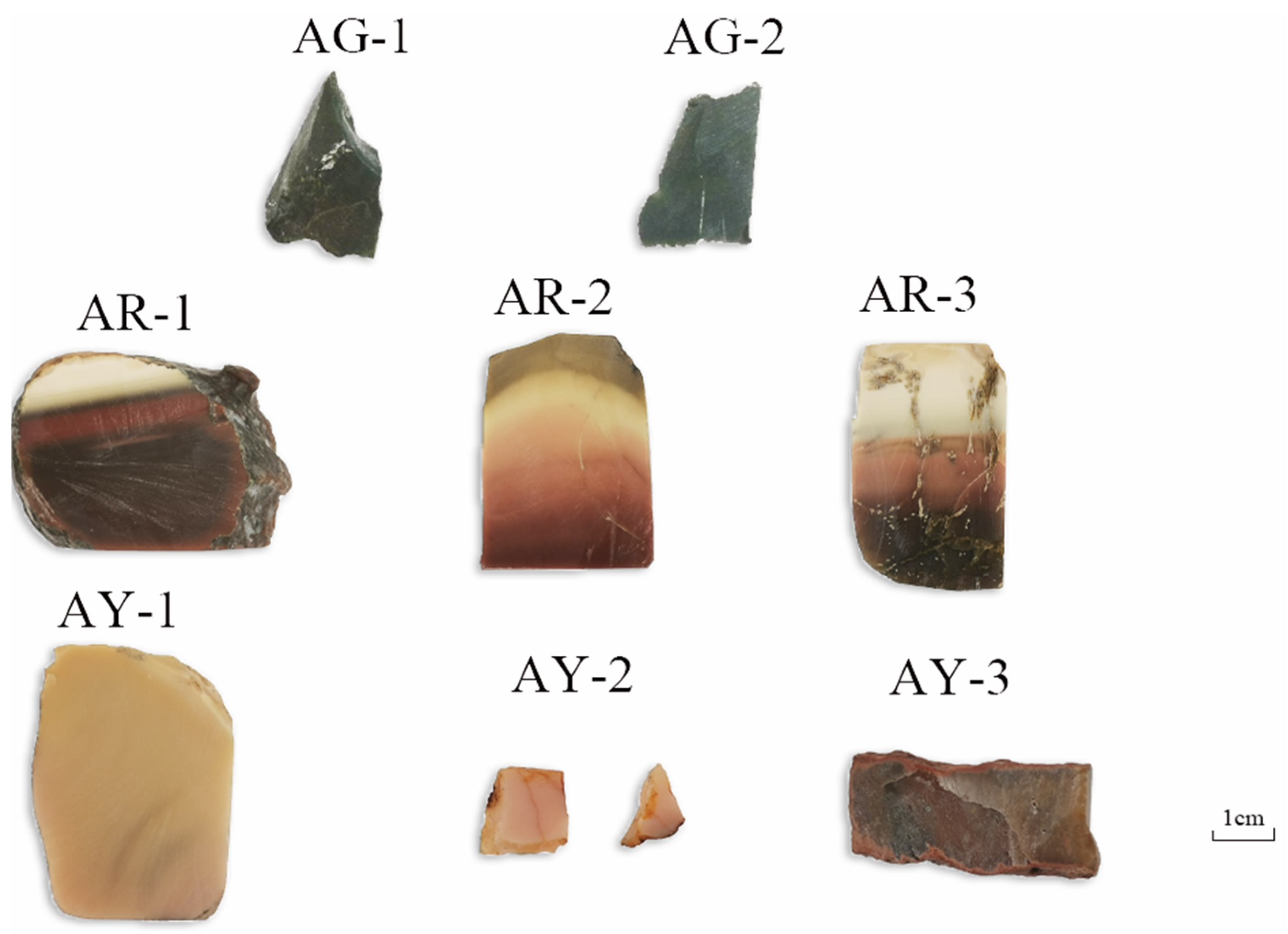

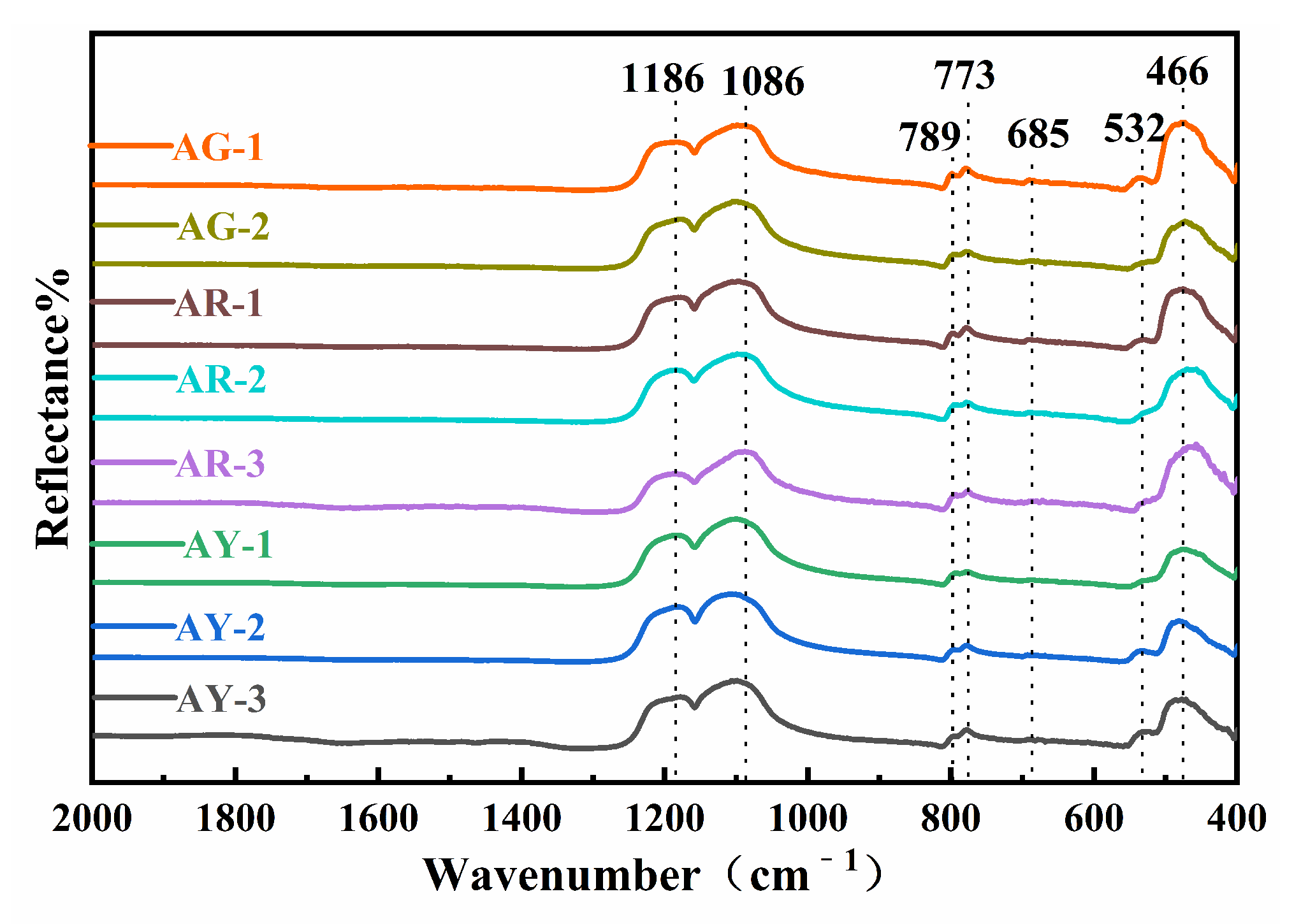
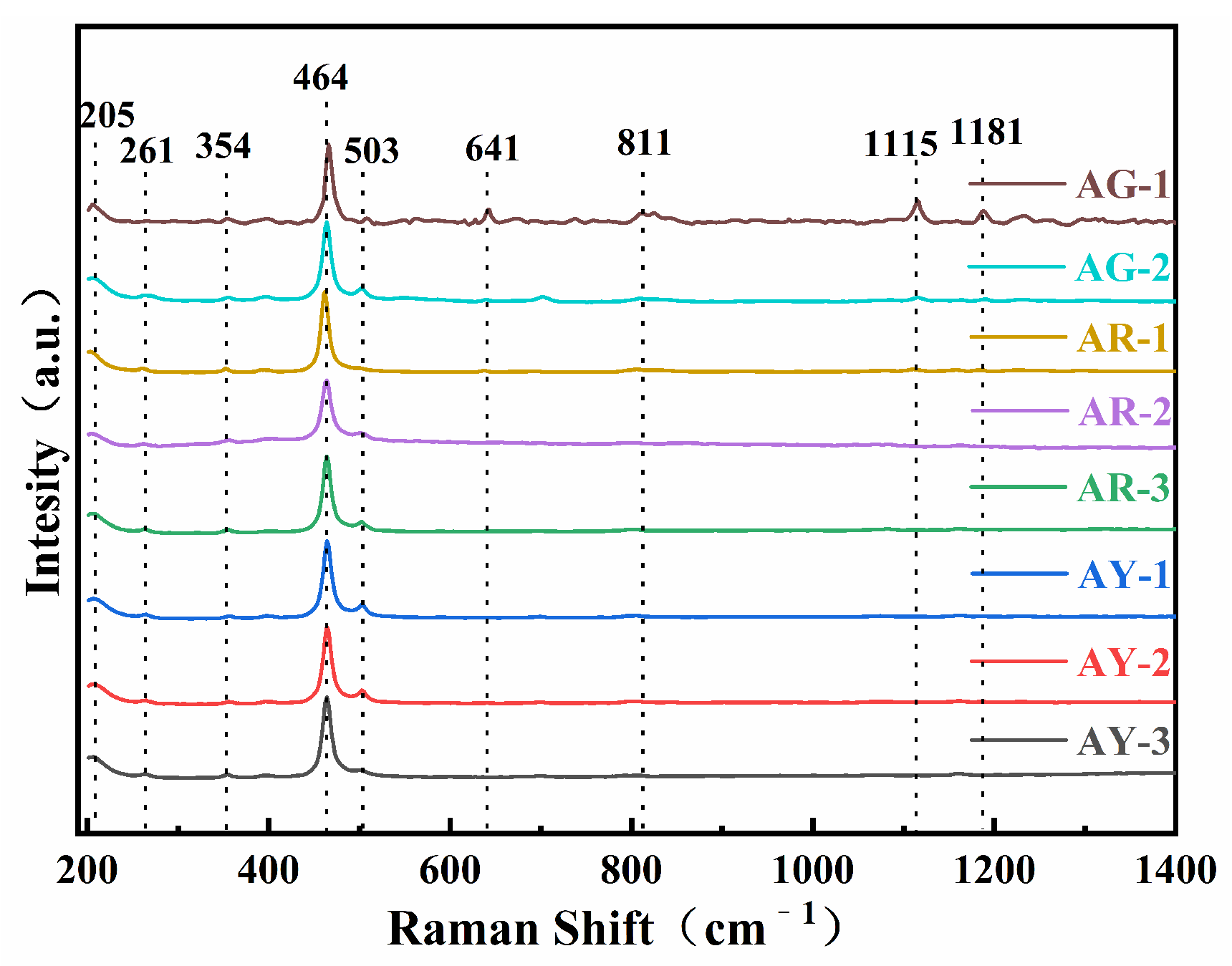

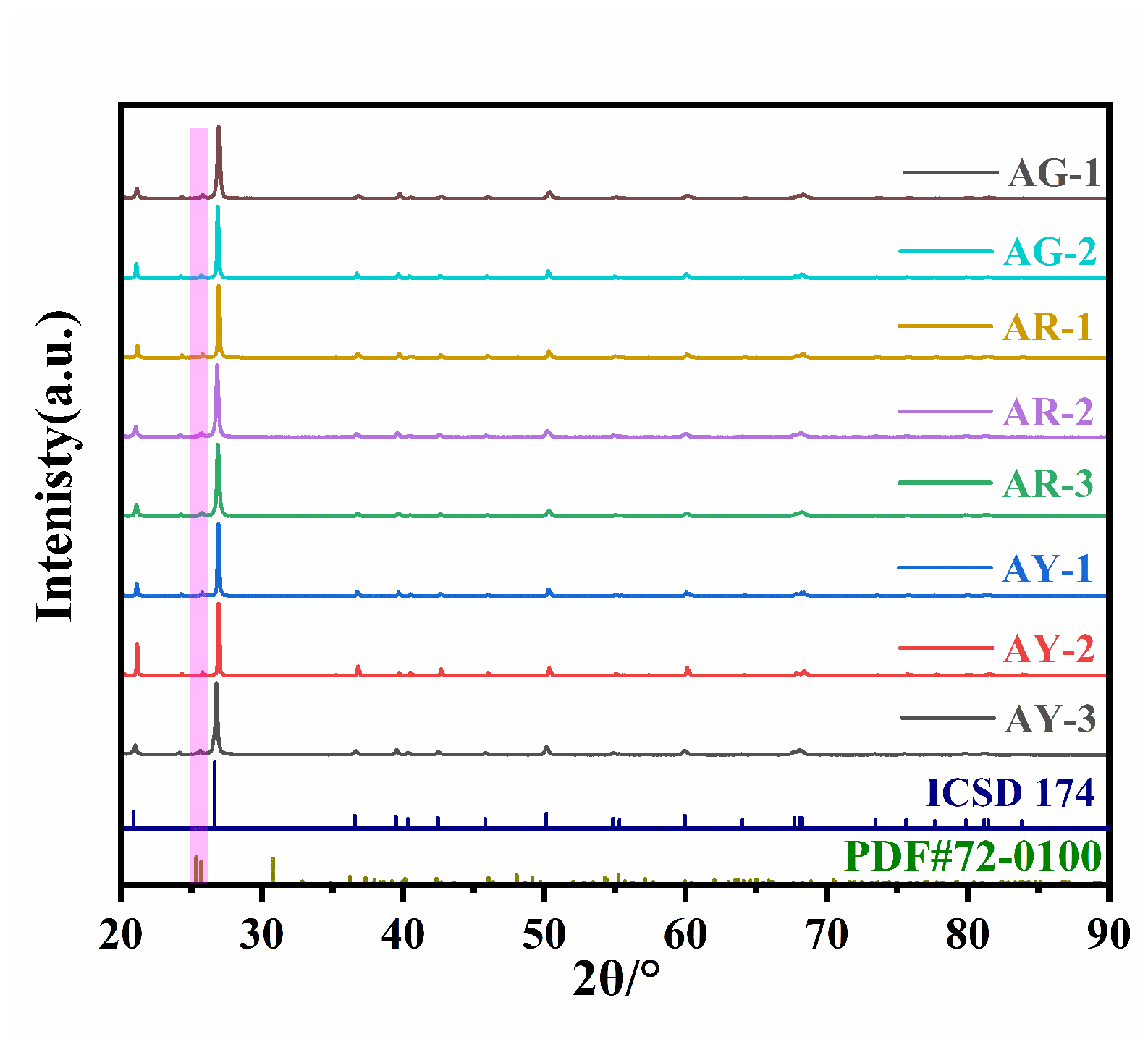
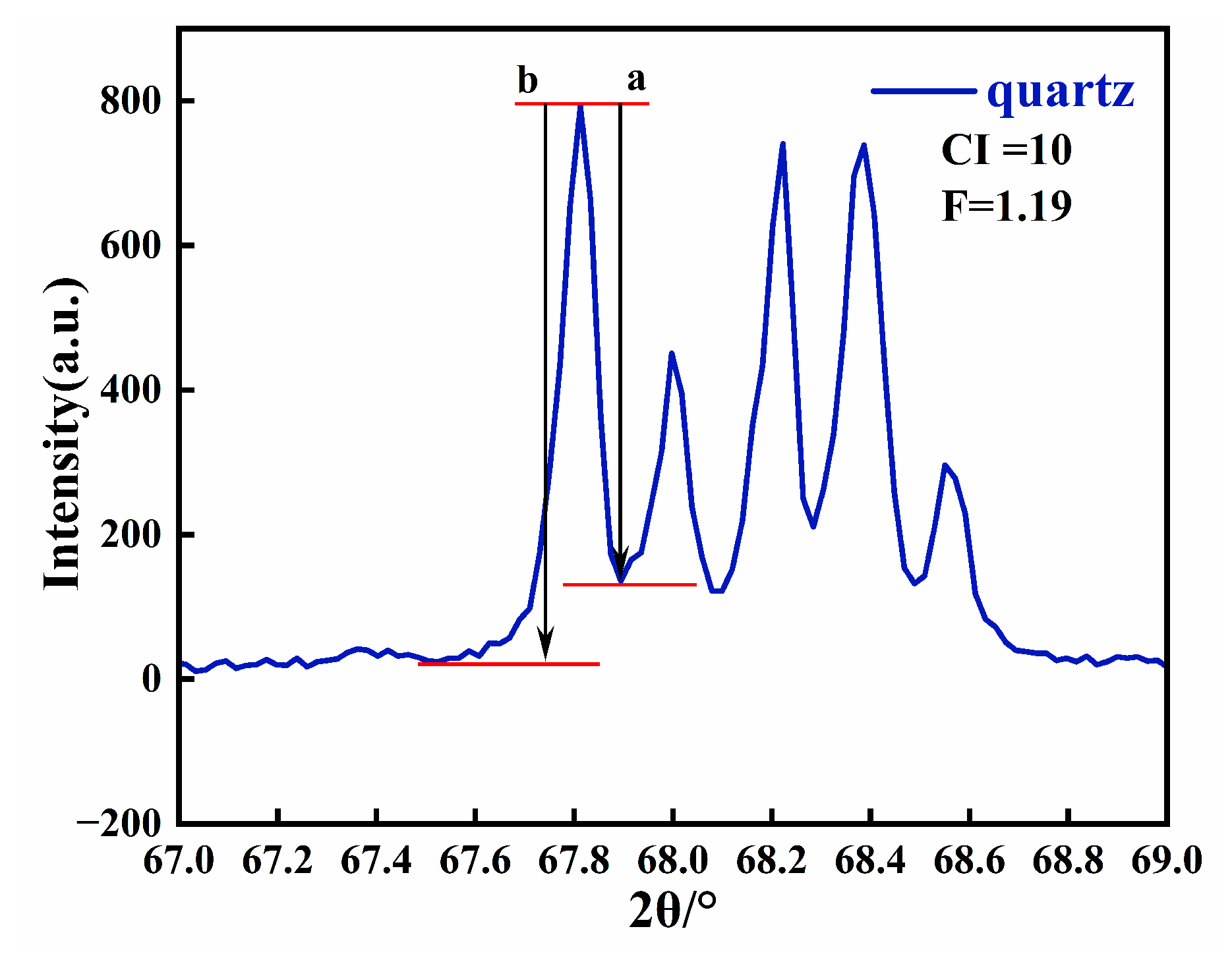
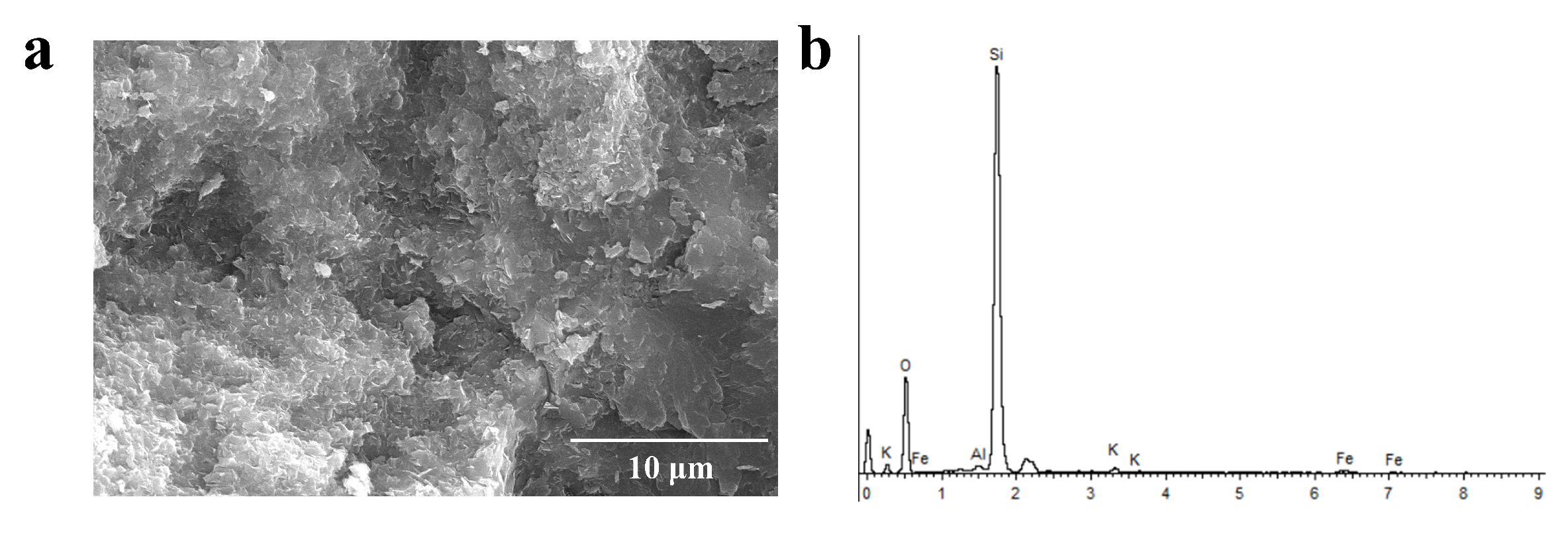

| Sample | Na2O | MgO | Al2O3 | SiO2 | K2O | CaO | TiO2 | FeO | NiO | CuO | MnO | Cr2O3 | Total |
|---|---|---|---|---|---|---|---|---|---|---|---|---|---|
| AG-1 | 0.13 | 0.44 | 0.75 | 95.79 | 1.17 | 0.11 | 0.16 | 1.1 | 0.17 | 0.2 | — | — | 100 |
| AG-2 | 0.16 | 0.51 | 0.79 | 96.51 | 0.85 | 0.08 | 0.1 | 0.94 | 0.08 | 0.14 | — | — | 100 |
| AR-1 | — | 0.09 | 0.8 | 98.27 | 0.12 | 0.1 | 0.28 | 0.12 | — | 0.13 | — | — | 100 |
| AR-2 | 0.04 | 0.02 | 0.62 | 98.35 | 0.06 | 0.18 | 0.16 | 0.11 | — | 0.18 | 0.12 | 0.16 | 100 |
| AR-3 | 0.13 | 0.06 | 0.69 | 97.83 | 0.11 | 0.15 | 0.21 | 0.18 | 0.25 | 0.17 | 0.15 | — | 100 |
| AY-1 | 0.04 | 0.05 | 0.72 | 98.76 | 0.03 | 0.13 | — | 0.05 | — | 0.29 | 0.05 | 0.08 | 100 |
| AY-2 | — | 0.03 | 0.34 | 98.63 | 0.06 | 0.07 | 0.17 | 0.18 | 0.22 | 0.15 | 0.17 | 100 | |
| AY-3 | 0.03 | 0.04 | 0.04 | 98.9 | 0.05 | 0.11 | 0.13 | 0.1 | 0.22 | 0.2 | 0.18 | — | 100 |
Disclaimer/Publisher’s Note: The statements, opinions and data contained in all publications are solely those of the individual author(s) and contributor(s) and not of MDPI and/or the editor(s). MDPI and/or the editor(s) disclaim responsibility for any injury to people or property resulting from any ideas, methods, instructions or products referred to in the content. |
© 2023 by the authors. Licensee MDPI, Basel, Switzerland. This article is an open access article distributed under the terms and conditions of the Creative Commons Attribution (CC BY) license (https://creativecommons.org/licenses/by/4.0/).
Share and Cite
Zhang, S.; Cui, L.; Guo, Q.; Li, N.; Liu, Y.; Rao, Y.; Liao, L. A Comparative Study on Gemological Characteristics and Color Formation Mechanism of Moqi Agate, Inner Mongolia Province, China. Crystals 2023, 13, 977. https://doi.org/10.3390/cryst13060977
Zhang S, Cui L, Guo Q, Li N, Liu Y, Rao Y, Liao L. A Comparative Study on Gemological Characteristics and Color Formation Mechanism of Moqi Agate, Inner Mongolia Province, China. Crystals. 2023; 13(6):977. https://doi.org/10.3390/cryst13060977
Chicago/Turabian StyleZhang, Sixue, Li Cui, Qingfeng Guo, Niu Li, Yang Liu, Yinghua Rao, and Libing Liao. 2023. "A Comparative Study on Gemological Characteristics and Color Formation Mechanism of Moqi Agate, Inner Mongolia Province, China" Crystals 13, no. 6: 977. https://doi.org/10.3390/cryst13060977





